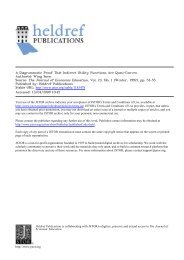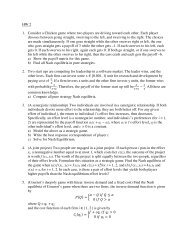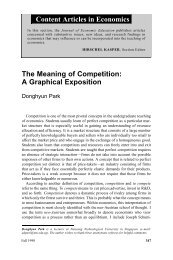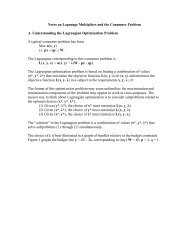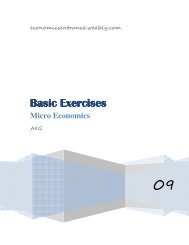In Class Exercises Problem 1 A group of n students go to a ...
In Class Exercises Problem 1 A group of n students go to a ...
In Class Exercises Problem 1 A group of n students go to a ...
Create successful ePaper yourself
Turn your PDF publications into a flip-book with our unique Google optimized e-Paper software.
Topics in Microeconomics 2009-10 Kirori Mal College, University <strong>of</strong> Delhi<br />
<strong>In</strong> <strong>Class</strong> <strong>Exercises</strong><br />
<strong>Problem</strong> 1<br />
A <strong>group</strong> <strong>of</strong> n <strong>students</strong> <strong>go</strong> <strong>to</strong> a restaurant. Each person will simultaneously choose his own meal<br />
but the <strong>to</strong>tal bill will be shared amongst all the <strong>students</strong>. If a student chooses a meal <strong>of</strong> price p<br />
and contributes x <strong>to</strong>wards paying the bill, then his pay<strong>of</strong>f is √p − x. Compute all pure strategy<br />
Nash equilibria <strong>of</strong> this game. Is the equilibrium unique? Symmetric? Discuss the limiting cases<br />
<strong>of</strong> n = 1 and n → ∞.<br />
<strong>Problem</strong> 2<br />
Each <strong>of</strong> n ≥ 2, i = 1, ..., n can make contributions si ∈ [0, w] (w > 0) <strong>to</strong> the production <strong>of</strong> some<br />
public <strong>go</strong>od. Their pay<strong>of</strong>f functions are given by πi (s1, .., sn) = n(min{s1, .., sn}) − si. Find all<br />
pure strategy Nash equilibria in the game.<br />
<strong>Problem</strong> 3<br />
Consider an n firm quantity setting game where the cost function for firm i is given by Ci(xi) =<br />
ci.xi where ci ≥ 0. The inverse demand function is given P(X) = a − bX where a, b > 0 and X = x1<br />
+ ... + xn. The pay<strong>of</strong>f function for firm i is therefore πi (x1, .., xn) = (a − b(∑j xj)xi − ci.xi.<br />
(i) Compute a (pure strategy) Nash equilibrium for the game. Compute also the equilibrium<br />
price.<br />
(ii) What happens <strong>to</strong> the equilibrium quantity choice <strong>of</strong> firm j if there is an increase in firm i’s<br />
cost; i.e in ci? What happens <strong>to</strong> equilibrium price?<br />
<strong>Problem</strong> 4<br />
Players 1 and 2 are bargaining over how <strong>to</strong> split one rupee. Both players simultaneously name<br />
shares they would like <strong>to</strong> have, s1 and s2, where 0 ≤ s1, s2 ≤ 1. If s1 + s2 ≤ 1, then the players<br />
receive the shares they named; if s1 + s2 > 1, then both players receive zero. What are the purestrategy<br />
Nash equilibria <strong>of</strong> the game?
Topics in Microeconomics 2009-10 Kirori Mal College, University <strong>of</strong> Delhi<br />
a. Write down the set <strong>of</strong> players, set <strong>of</strong> terminal his<strong>to</strong>ries, player function, and players’<br />
preferences for the game above<br />
b. Represent the above game in normal form and suggest the Nash Equilibria.<br />
c. How many subgames does the game above has? Find all Nash Equilibrium <strong>of</strong> each<br />
subgame <strong>of</strong> the game above.<br />
d. Now, Find subgame perfect Nash Equilibrium. What is the outcome if SPNE is played?<br />
EXERCISE 154.2 (Examples <strong>of</strong> extensive games with perfect information)<br />
a. Represent in a diagram the two-player extensive game with perfect information in which<br />
the terminal his<strong>to</strong>ries are (C, E), (C, F), (D, G), and (D, H), the player function is given<br />
by P(∅) = 1 and P(C) = P(D) = 2, player 1 prefers (C, F) <strong>to</strong> (D, G) <strong>to</strong> (C, E) <strong>to</strong> (D, H),<br />
and player 2 prefers (D, G) <strong>to</strong> (C, F) <strong>to</strong> (D, H) <strong>to</strong> (C, E).<br />
b. The political figures Rosa and Ernes<strong>to</strong> each has <strong>to</strong> take a position on an issue. The<br />
options are Berlin (B) or Havana (H). They choose sequentially. A third person, Karl,<br />
determines who chooses first. Both Rosa and Ernes<strong>to</strong> care only about the actions they<br />
choose, not about who chooses first. Rosa prefers the outcome in which both she and<br />
Ernes<strong>to</strong> choose B <strong>to</strong> that in which they both choose H, and prefers this outcome <strong>to</strong> either<br />
<strong>of</strong> the ones in which she and Ernes<strong>to</strong> choose different actions; she is indifferent between<br />
these last two outcomes. Ernes<strong>to</strong>’s preferences differ from Rosa’s in that the roles <strong>of</strong> B<br />
and H are reversed. Karl’s preferences are the same as Ernes<strong>to</strong>’s. Model this situation as<br />
an extensive game with perfect information. (Specify the components <strong>of</strong> the game and<br />
represent the game in a diagram.)<br />
c. Write down the set <strong>of</strong> players, set <strong>of</strong> terminal his<strong>to</strong>ries, player function, and players’<br />
preferences for the game in Figure below:<br />
d. Represent the above games in normal forms carefully listing the strategies and the pay<strong>of</strong>fs, solve<br />
for Nash Equilibrium and Sub-game perfect Nash Equilibrium.<br />
EXERCISE 161.2 (Voting by alternating ve<strong>to</strong>) Two people select a policy that affects them both<br />
by alternately ve<strong>to</strong>ing policies until only one remains. First person 1 ve<strong>to</strong>es a policy. If more<br />
than one policy remains, person 2 then ve<strong>to</strong>es a policy. If more than one policy still remains,
Topics in Microeconomics 2009-10 Kirori Mal College, University <strong>of</strong> Delhi<br />
person 1 then ve<strong>to</strong>es another policy. The process continues until only one policy has not been<br />
ve<strong>to</strong>ed. Suppose there are three possible policies, X, Y, and Z, person 1 prefers X <strong>to</strong> Y <strong>to</strong> Z, and<br />
person 2 prefers Z <strong>to</strong> Y <strong>to</strong> X. Model this situation as an extensive game and find its Nash<br />
equilibria.<br />
EXERCISE 171.4 (Burning a bridge) Army 1, <strong>of</strong> country 1, must decide whether <strong>to</strong> attack army<br />
2, <strong>of</strong> country 2, which is occupying an island between the two countries. <strong>In</strong> the event <strong>of</strong> an attack,<br />
army 2 may fight, or retreat over a bridge <strong>to</strong> its mainland. Each army prefers <strong>to</strong> occupy the<br />
island than not <strong>to</strong> occupy it; a fight is the worst outcome for both armies. Model this situation as<br />
an extensive game with perfect information and show that army 2 can increase its subgame<br />
perfect equilibrium pay<strong>of</strong>f (and reduce army 1’s pay<strong>of</strong>f) by burning the bridge <strong>to</strong> its mainland,<br />
eliminating its option <strong>to</strong> retreat if attacked.
Topics in Microeconomics 2009-10 Kirori Mal College, University <strong>of</strong> Delhi<br />
EXERCISE 183.2 (Dividing a cake fairly) Two players use the following procedure <strong>to</strong> divide a<br />
cake. Player 1 divides the cake in<strong>to</strong> two pieces, and then player 2 chooses one <strong>of</strong> the pieces;<br />
player 1 obtains the remaining piece. The cake is continuously divisible (no lumps!), and each<br />
player likes all parts <strong>of</strong> it.<br />
a. Suppose that the cake is perfectly homogeneous, so that each player cares only about the size<br />
<strong>of</strong> the piece <strong>of</strong> cake she obtains. How is the cake divided in a subgame perfect equilibrium?<br />
b. Suppose that the cake is not homogeneous: the players evaluate different parts <strong>of</strong> it differently.<br />
Represent the cake by the set C, so that a piece <strong>of</strong> the cake is a subset P <strong>of</strong> C. Assume that if P is<br />
a subset <strong>of</strong> P’ not equal <strong>to</strong> P’ (smaller than P’) then each player prefers P’ <strong>to</strong> P. Assume also<br />
that the players’ preferences are continuous: if player i prefers P <strong>to</strong> P’ then there is a subset <strong>of</strong> P<br />
not equal <strong>to</strong> P that player i also prefers <strong>to</strong> P’. Let (P1, P2) (where P1 and P2 <strong>to</strong>gether constitute<br />
the whole cake C) be the division chosen by player 1 in a subgame perfect equilibrium <strong>of</strong> the<br />
divide-and-choose game, P2 being the piece chosen by player 2. Show that player 2 is indifferent<br />
between P1 and P2, and player 1 likes P1 at least as much as P2. Give an example in which player<br />
1 prefers P1 <strong>to</strong> P2.<br />
EXERCISE 188.1 (Stackelberg’s duopoly game with fixed costs) Suppose that the inverse<br />
demand function is given by<br />
and the cost function <strong>of</strong> each firm i is<br />
where c ≥ 0, f > 0, and c < α. Show that if c = 0, α = 12, and f = 4, Stackelberg’s game has a<br />
unique subgame perfect equilibrium, in which firm 1’s output is 8 and firm 2’s output is zero.<br />
A legislature has k members, where k is an odd number. Two rival bills, X and Y, are being<br />
considered. The bill that attracts the votes <strong>of</strong> a majority <strong>of</strong> legisla<strong>to</strong>rs will pass. <strong>In</strong>terest <strong>group</strong> X<br />
favors bill X, whereas interest <strong>group</strong> Y favors bill Y. Each <strong>group</strong> wishes <strong>to</strong> entice a majority <strong>of</strong><br />
legisla<strong>to</strong>rs <strong>to</strong> vote for its favorite bill. First interest <strong>group</strong> X gives an amount <strong>of</strong> money (possibly<br />
zero) <strong>to</strong> each legisla<strong>to</strong>r, then interest <strong>group</strong> Y does so. Each interest <strong>group</strong> wishes <strong>to</strong> spend as<br />
little as possible. Group X values the passing <strong>of</strong> bill X at $VX > 0 and the passing <strong>of</strong> bill Y at<br />
zero, and <strong>group</strong> Y values the passing <strong>of</strong> bill Y at $VY > 0 and the passing <strong>of</strong> bill X at zero. (For<br />
example, <strong>group</strong> X is indifferent between an outcome in which it spends VX and bill X is passed<br />
and one in which it spends nothing and bill Y is passed.) Each legisla<strong>to</strong>r votes for the favored<br />
bill <strong>of</strong> the interest <strong>group</strong> that <strong>of</strong>fers her the most money; a legisla<strong>to</strong>r <strong>to</strong> whom both <strong>group</strong>s <strong>of</strong>fer<br />
the same amount <strong>of</strong> money votes for bill Y (an arbitrary assumption that simplifies the analysis<br />
without qualitatively changing the outcome). For example, if k = 3, the amounts <strong>of</strong>fered <strong>to</strong> the<br />
legisla<strong>to</strong>rs by <strong>group</strong> X are x = (100, 50, 0), and the amounts <strong>of</strong>fered by <strong>group</strong> Y are y = (100, 0,<br />
50), then legisla<strong>to</strong>rs 1 and 3 vote for Y and legisla<strong>to</strong>r 2 votes for X, so that Y passes. (<strong>In</strong> some<br />
legislatures the inducements <strong>of</strong>fered <strong>to</strong> legisla<strong>to</strong>rs are more subtle than cash transfers.)
Topics in Microeconomics 2009-10 Kirori Mal College, University <strong>of</strong> Delhi<br />
We can model this situation as the following extensive game.<br />
Players The two interest <strong>group</strong>s, X and Y.<br />
Terminal his<strong>to</strong>ries The set <strong>of</strong> all sequences (x, y), where x is a list <strong>of</strong> payments <strong>to</strong> legisla<strong>to</strong>rs<br />
made by interest <strong>group</strong> X and y is a list <strong>of</strong> payments <strong>to</strong> legisla<strong>to</strong>rs made by interest <strong>group</strong> Y.<br />
(That is, both x and y are lists <strong>of</strong> k nonnegative integers.)<br />
Player function P(∅) = X and P(x) = Y for all x.<br />
Preferences The preferences <strong>of</strong> interest <strong>group</strong> X are represented by the pay<strong>of</strong>f function<br />
where bill Y passes after the terminal his<strong>to</strong>ry (x, y) if and only if the number <strong>of</strong> components <strong>of</strong> y<br />
that are at least equal <strong>to</strong> the corresponding components <strong>of</strong> x is at least 0.5 (k + 1) (a bare<br />
majority <strong>of</strong> the k legisla<strong>to</strong>rs). The preferences <strong>of</strong> interest <strong>group</strong> Y are represented by the<br />
analo<strong>go</strong>us function (where VY replaces VX, y replaces x, and Y replaces X).<br />
EXERCISE 193.1 (Three interest <strong>group</strong>s buying votes) Consider a variant <strong>of</strong> the model in which<br />
there are three bills, X, Y, and Z, and three interest <strong>group</strong>s, X, Y, and Z, who choose lists <strong>of</strong><br />
payments sequentially. Ties are broken in favor <strong>of</strong> the <strong>group</strong> moving later. Find the bill that is<br />
passed in any subgame perfect equilibrium when k = 3 and (a) VX = VY = VZ = 300, (b) VX =<br />
300, VY = VZ = 100, and (c) VX = 300, VY = 202, VZ = 100.<br />
EXERCISE 193.4 (Sequential positioning by three political candidates) Consider a further<br />
variant <strong>of</strong> Hotelling’s model <strong>of</strong> elec<strong>to</strong>ral competition in which the n candidates choose their<br />
positions sequentially and each candidate has the option <strong>of</strong> staying out <strong>of</strong> the race. Assume that<br />
each candidate prefers <strong>to</strong> stay out than <strong>to</strong> enter and lose, prefers <strong>to</strong> enter and tie with any<br />
number <strong>of</strong> candidates than <strong>to</strong> stay out, and prefers <strong>to</strong> tie with as few other candidates as<br />
possible. Model the situation as an extensive game and find the subgame perfect equilibrium<br />
outcomes when n = 2 (easy) and when n = 3 and the voters’ favorite positions are distributed<br />
uniformly from 0 <strong>to</strong> 1 (i.e. the fraction <strong>of</strong> the voters’ favorite positions less than x is x) (hard).
Topics in Microeconomics 2009-10 Kirori Mal College, University <strong>of</strong> Delhi<br />
1. Consider the first-price sealed-bid auction, but each bidder i observes only his own valuation<br />
vi. The valuation is distributed uniformly and independently on [0, v*] for each bidder.<br />
Derive symmetric (pure strategy) Bayesian Nash equilibrium <strong>of</strong> this auction if there are two<br />
bidders. Suppose that bids can only be non-negative. (Look for an equilibrium in which<br />
bidder i’s bid is a linear function <strong>of</strong> his valuation.)<br />
2. Consider the following strategic situation. Two opposed armies are poised <strong>to</strong> seize an island.<br />
Each army’s general can choose either “attack” or “not attack.” <strong>In</strong> addition, each army is<br />
either “strong” or “weak” with equal probability (the draws for each army are independent),<br />
and an army’s type is known only <strong>to</strong> its general. Pay<strong>of</strong>fs are as follows: The island is worth<br />
M if captured. An army can capture the island either by attacking when its opponent does not<br />
or by attacking when its rival does if it is strong and its rival is weak. If two armies <strong>of</strong> equal<br />
strength both attack, neither captures the island. An army also has a “cost” <strong>of</strong> fighting,<br />
which is s if it is strong and w if it is weak, where s
Topics in Microeconomics 2009-10 Kirori Mal College, University <strong>of</strong> Delhi<br />
simultaneous and independent choices and receive pay<strong>of</strong>fs as described by the following<br />
matrix.<br />
1↓2 → X Y<br />
A 0, 1 1, 0<br />
B 1, 0 c, 1<br />
Compute the Bayesian Nash equilibrium.<br />
6. Consider the following game. Nature selects A with probability ½ and B with probability ½.<br />
If nature selects A, then players 1 and 2 interact according <strong>to</strong> matrix “A”. If nature selects B,<br />
then the players interact according <strong>to</strong> matrix “B”. Suppose that, before the players select<br />
their actions, player 1 observes nature’s choice. (That is, player 1 knows which matrix is<br />
being played.) Player 2 does not observe nature’s choice. These matrices are pictured here.<br />
A B<br />
1↓2 → L R 1↓2 → L R<br />
U 2, 2 0, 0 U 0, 2 2, 0<br />
D 0, 0 4, 4 D 4, 0 0, 4<br />
Solve for Bayesian Nash equilibrium.<br />
7. Consider a Cournot duopoly game with incomplete information. Suppose that demand is<br />
given by p = max{10 – Q, 0}, where Q is the <strong>to</strong>tal quantity produced in the industry. Firm 1<br />
selects a quantity q1, which it produces at zero cost. Firm 2’s cost <strong>of</strong> production is private<br />
information (selected by nature). With probability ½, firm 2 produces at zero cost. With<br />
probability ½, firm 2 produces with a marginal cost <strong>of</strong> 2. Call the former type <strong>of</strong> firm 2 “L”<br />
and the latter type “H” (for low and high cost, respectively). Firm 2 knows its type, whereas<br />
firm 1 knows only the probability that L and H occur. Let q2 H and q2 L denote the quantities<br />
selected by the two types <strong>of</strong> firm 2. Then when firm 2’s type is L, its pay<strong>of</strong>f is given by u2 L =<br />
(10 – q1 – q2 L )q2 L . When firm 2’s type is H, its pay<strong>of</strong>f is u2 L = (10 – q1 – q2 H )q2 H – (2q2 H ). As a<br />
function <strong>of</strong> the strategy pr<strong>of</strong>ile (q1; q2 L , q2 H ), firm 1’s pay<strong>of</strong>f is u1 = ((10 – q1 – q2 L )q1)/2 +<br />
((10 – q1 – q2 H )q1)/2. Solve for Bayesian Nash Equilibrium.


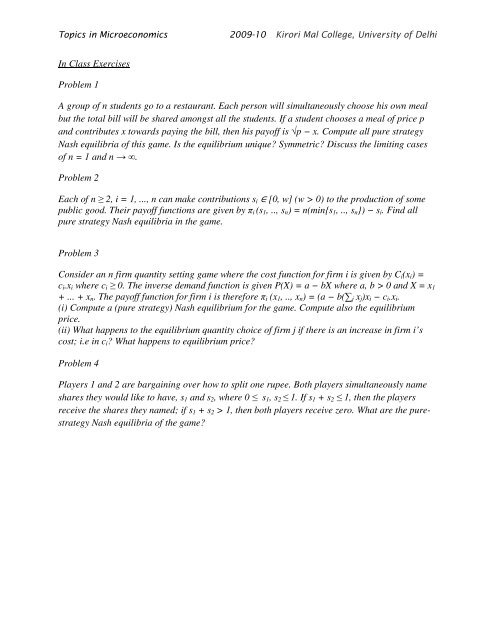

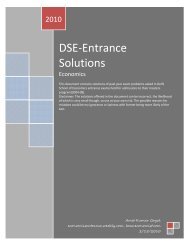


![2. Each of n ≥ 2, i = 1, ..., n can make contributions s i ∈ [0, w] (w ...](https://img.yumpu.com/19311695/1/190x245/2-each-of-n-2-i-1-n-can-make-contributions-s-i-0-w-w-.jpg?quality=85)
